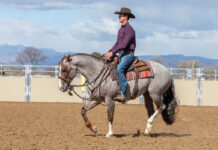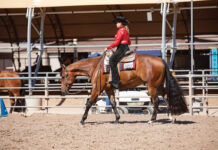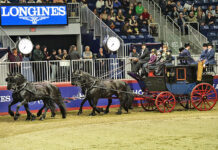Go to any barrel racing or pole bending competition, and you’re bound to see at least a few horses spinning in circles, out of control or refusing to enter the in-gate. Their worried riders may try to back the misbehaving horses into the pen, whip or spur them in, or have another horse and rider usher them to the gate. What’s the problem? Why are these horses acting this way, and if your horse is one of them, what can you do to improve things?
Using a three-pronged approach—health, feed and training—you and your horse will be well on your way to entering the in-gate and handling competitions without a fuss.
|
Is Pain the Problem?
Dr. Burgard explains that first and foremost, recognize that getting a bit jazzed up at competition is a natural thing for a speed horse, just as a person might get nervous before a public speaking engagement. However, some horses cross the line between behavior that is reasonable before a race and behavior that is unacceptable. “Certainly it does go over the top when the horse spins, tries to dump you, rub you off on the fences or run backward,” Dr. Burgard says. While a horse may get excited, he must always remain under control.
Out-of-control behavior, including refusal to enter the in-gate, may simply be a sign a particular horse can’t handle the anxiety of speed competition, but according to Dr. Burgard, these behaviors are more often related to some sort of physical pain. Pinpointing the source of the pain, however, can be quite difficult. “The horse may appear completely sound,” she says. “It really takes a comprehensive, complete exam. If you have a horse that’s not performing to potential or doing all of these agitating things, he needs a whole workover.”
“But wait a minute!” you might say. “My horse is fine when we ride at home. If he had a physical problem, wouldn’t he act up every time we practice, not just at shows?” Not necessarily. Keep in mind that a horse doesn’t usually run full speed at home. This level of exertion may only happen at shows, and when your horse arrives at the showgrounds or is asked to enter the competition pen, he knows what is going to happen next, and what’s going to happen next may be painful for him.
Dr. Burgard points out that stifle problems and suspensory ligament injuries are quite common for barrel racing horses. Back pain from an ill-fitting saddle or a rider that is too heavy for the horse may also be to blame for behavior problems.
“A very common barrel racing injury is to the sacroiliac, or the SI joint, which is where the backbone is in place with the pelvis, and it’s held together with ligaments that can tear, stretch or strain,” Dr. Burgard explains. She says many people wouldn’t even know an injury had occurred in this area until the horse is palpated by a veterinarian.
But in Dr. Burgard’s opinion, hock problems are the most common of all. “If I were to give a percentage it would be greater than 50 percent [of performance horses] need treatment for their hocks,” she says. Treatment can include injecting hyaluronic acid and/or cortisone directly into the joints, or intravenous injections such as Legend IV or intramuscular injections such as Adequan.
Linda agrees that behavior problems are often caused by pain, and reminds riders to make sure their saddles and tack fit correctly. “You want to check all of your equipment and make sure everything’s fitting right and that the horse doesn’t have any pain,” she says.
As for complementary therapies, such as chiropractic and acupuncture, Dr. Burgard believes they can help but, unfortunately, some horse owners use them to treat the symptoms rather than getting to the cause of the problem. So before deciding on a complementary therapy for your horse, consult your veterinarian.
Feed Findings
| Wrong Horse or Rider?
On the other hand, some horses perform just fine for one rider and not another. “The horse and rider have to be properly matched,” Linda says. “The horse might be more horse than the rider can control. Horses are very smart animals, and they know what a rider can or can’t do. Put a person on a horse that’s more than they can handle, and the horse will take advantage of them.” If this might be the case with you and your horse, consider finding a mount more suited to your skill level or personality.
|
If your horse gets a clean bill of health from your veterinarian, your search for behavior solutions can then turn to his diet. Remember, we are what we eat, and just as sugar and caffeine may have us darting about the home or office, the wrong diet can make your horse high as a kite. “You might be overfeeding your horse a grain mix, and some horses can’t handle this,” Linda says. “Maybe they don’t need the grain, or you can change your rations to something different. There are [certain] feeds that tend to make a horse higher than other feeds.”
Dr. Burgard agrees and finds that often when a horse is very excitable, he has a diet too high in carbohydrates, such as a horse getting too much grain and rich alfalfa hay. “I’m not a fan of feeding horses straight alfalfa hay,” she says. “I think a combination of alfalfa with either a three-way mix grain hay, Bermuda or coastal grass hay is really good.
“There’s a lot of research being done right now on horse feed,” Dr. Burgard continues. She says that much of the research points to the benefits of fat in a horse’s diet, especially fat balanced in Omega-3 and Omega-6 fatty acids. Beneficial ingredients in supplements, such as Omegas and antioxidants, can have a positive impact on a horse’s behavior, she says. Dr. Burgard points out that instead of giving horses a lot of expendable energy, a diet higher in Omegas and antioxidants helps horses be “more focused mentally and physically.”
Because a horse’s dietary needs are different based on his health and activity level, it’s best to consult your veterinarian to develop a feeding plan ideal for your horse. If you have concerns about your horse’s behavior, discuss them with your veterinarian so that he or she can take them into account when making recommendations.
Schooling Solutions
If yourhorse is still acting up after you’ve carefully evaluated his health and diet, you can focus on schooling at home and at competitions to improve his performance behavior.
At Home
“In my opinion horses get [speed event behavior problems] from being run too much and out of control—where the rider just likes to run them,” Linda says. Instead of running the horse during her practice sessions, Linda concentrates on slow work and keeps training fun and enjoyable for the horse. Here are a few things to try at home:
- If your horse has problems entering the gate at competitions, you can teach him the gate is a place of rest and relaxation. “Walk into the arena, stop and let the horse relax at the gate,” Linda advises.
- Don’t overdo the pattern at home, and don’t run the pattern full speed at home. “I don’t believe in running [the pattern] every day, and I don’t believe in overtraining horses—sometimes less is more,” Linda says.“You can do slow work every day. I take my horse around the barrels slow quite often, but I don’t run him,” Linda explains. “I don’t run him at all on the barrels unless I have a problem, something I need to have corrected.“Always be under control,” she adds. “If you’re out there going fast, and you’re not under control, you’re not teaching the horse anything.” Linda says she may walk, jog, lope or even gallop a pattern during practice, but she concentrates on doing it correctly rather than fast. “I don’t just go full speed around the barrels. I try to make my practice perfect,” she says.
- When you do practice the pattern at home, do something different afterward. “Work the horse on the barrels, and then do something after, like go for a trail ride,” Linda suggests. “Keep it fun for him. Don’t always get on and run him because that just gets the horse more hyped up and gets him so that he doesn’t like his job.”
At the Competition
As explained earlier, it’s somewhat natural for horses to get excited at competition, as long as that excitement doesn’t go too far. “There’s nothing wrong with getting wound up in competition,” Linda says. “It doesn’t hurt for them to know it’s their turn, but it’s got to be under control.”
To help your horse stay under control at competitions, Linda has a number of suggestions:
- Every horse needs a different type of warmup for optimum performance, so find a workout that doesn’t overly stimulate your sensitive horse. “For horses who are hotter, I do slow work—long trotting and slow loping, loping in circles,” Linda explains. “You don’t want to get a really hot horse’s adrenaline going.”
- For horses that refuse to enter the in-gate or get wound up approaching the gate, it can be helpful to practice hanging out and relaxing by the gate; however, make sure to stay clear of riders entering and exiting the competition arena. “I sit on my horse sometimes by the gate and just let him relax and watch,” Linda says. “If your horse won’t stand, you can get off and hold him by the gate where he can learn to relax and get comfortable.”She suggests you warm your horse up first, and then go up and stand quietly with him before it’s your turn to go into the arena.
- Remember that horses pick up on how you’re feeling, so try to stay relaxed and focused. “As riders we ‘telegraph’ to the horse that it’s our turn,” Linda explains. “You could be sitting there, and your horse is really quiet, and you hear your name called, and the next thing you know he’s all excited. It’s because you telegraphed it.”Linda suggests riders visualize a successful performance. “Don’t think, ‘Oh, no, my horse isn’t going to do this,’ ” Linda explains. “I believe in thinking positive and keeping calm and cool. Know, ‘This is what you’re going to do’—there are no ifs ands or buts about it.
- “When it’s your turn to go, don’t dilly dally,” Linda says. Instead, concentrate on keeping the horse moving forward, in and through the in-gate.
Linda explains that anything in the way as you go to enter the gate, such as another horse and rider, can disrupt your smooth entry and cause a nervous horse to begin fretting or refusing. “Make sure the gate is clear, and you can go right in,” Linda says.
With these schooling strategies for the speed-event performer, and a careful evaluation of your horse’s health and diet, the two of you will soon be ready to perform to the best of your abilities.
Further Reading
Barrel Essentials
Micaela Myers competed in gymkhanas throughout her youth and is currently a freelance writer in California.
This article originally appeared in the August 2006 issue of Horse Illustrated. Click here to subscribe.







I like the article as I see many of those kind of horses at gaming competitions. I would also like to add that it may be the riders fault. Let me guess, when you are practicing at home, you try to use all the proper cues and are very considerate. However, when people get to an actual competition, all that changes. When we get in the gate, we give the horse a big kick or smack him with a bat, andthen when the horses are running for all it’s worth we still beat on them and when we start our turns, we start jerking on their mouths. How would you feel if you were trying your absolute best and then get beat for it!?? The next time you go to a competition, be more considerate of your horse…and then maybe he won’t be so gate sour
Very well written. It taught me how to get started with barrel racing. Thanks!
good info
This good information and helpful when it comes to keeping your horse from getting gate sour, but once they’ve gotten to the spinning away and bolting backward stage, they usually require a change of career. Most sour barrel horses have been gamed too much with ill fitting tack or inconsiderate riders and will not learn to trust again.
very good info
nice!
I have to back my barrel horse into the arena. He refuses to walk straight in but his backing up is perfectly straight, I turn him and point him to the first barrel and away we go. It is quirky, but it works for us.
My pony is a hot headed little thing. I currently blindfold him and have him led into the arena. My mom then takes the blindfold off, and there we go! He sits so calmly at the gate, but when I start walking him closer, he freezes up and rears. Blindfolding is just safer for everyone. He is not a vicious pony by no means; he just loves barrels! Cole is nineteen years old and still runs like a champ, though. 🙂
My barrel horse doesn’t have any I those problems he’s been bet checked his teeth have been check the whole nine yards. I don’t over pattern him he works great he’s finished in the arena but not in the gate he locks up an reuses to go forward.
Interesting article… I got to reading because today I was making a run. (first time in a week) I didnt even make it to the arena before my horse backed up all the way to the barn on the driveway and slipped and fell.. Broke my foot and two of his teeth.. Almost trampled my friend in the process. I’m SO OVER this gate sour crap. I don’t understand it! He loves to run but why get so hot?! He is normally a 3-4 on the hot scale. But when he knows were going to make a run, it goes up to a 15 on the hot scale.